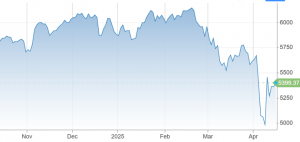Tariffs Pause and Markets Scramble to Adjust
Thaddius Gamueda
Staff Writer
Tariffs Pause and Markets Scramble to Adjust
As the White House announced a 90-day pause on all tariffs, except on China, the stock market has experienced some of its most volatile weeks in recent history. The current tariffs in place include:
-
125% on all Chinese goods, excluding smartphones and electronic parts.
-
25% on aluminum and auto goods from Mexico and Canada. Excludes goods protected by the United States-Mexico-Canada Agreement.
-
10% on all other imports.
Turbulent swings, with nearly 10% shifts, created uncertainty reminiscent of the COVID-19 selloff. Worldwide, investors are panicking and struggling to find the best ways to protect their money.
How Did American Markets React?
We will analyze each major index and its reaction to the stock market selloff. These data were collected after the close of April 14, 2025.
Dow Jones Industrial Average
The Dow is performing the best of the four major indices. It is currently at $40,524.79, which is 9.19% lower than its all-time high of $44,627.59 set on February 19, 2025. Dow Jones proves its resilience to market swings due to a high concentration of blue-chip non-cyclical companies, which protected the index from larger losses.
S&P 500
The S&P has been teetering on correction and sliding toward a bear market ever since the “Liberation Day” tariffs on autos, semiconductors, and steel were unveiled on April 2. It is currently down 12.03% from its February 19 record of 6,144.15. Sitting at 5,405.97, it is about 8.0% away from a 20% bear market decline. The announcement of the 90-day pause on tech related levies provided only fleeting relief amid persistent policy uncertainty.

Nasdaq Composite
The Nasdaq was in a bear market just days ago but is now edging back toward correction territory. After Trump’s exemption of smartphones and computers from the steepest levies, tech giants rallied, lifting the index to 16,831.48, 16.08% below its February 19, 2025, high of 20,056.25. While supply chain pressures have eased for Apple and Microsoft, tariffs on semiconductors and equipment remain a looming threat.
Russell 2000
The Russell 2000 is performing the worst of the four. Composed of smaller companies, it is more sensitive to rising input costs from tariffs. It currently sits at 1,880.88, down 23.76% from its November 25, 2024, record close of 2,466.49. This heavy drop has put the index in bear market territory that historically lasts around 9-12 months on average. Small cap manufacturers and distributors have seen margins squeezed as levies on imported parts and materials cut into profitability
Overall, each of the indices is reeling from the impact of Trump’s tariffs, with some performing better than others. The situation is no different internationally.
Impact of Tariffs on International Markets
Now, let’s turn our attention overseas. After the close of April 14, 2025, major indices across Europe and Asia reflected the direct impact of U.S. tariff decisions on their markets.
FTSE 100 (UK, GBP)
The FTSE 100 closed at £8,134.34, a 6.24% drop from its all-time high of £8,679.46 on January 31, 2025, leaving it 13.76% above bear market territory. Over the week of April 7–14, 2025, it rallied 5.61% from 7,702.08 as President Trump’s exemption of smartphones and computers from reciprocal tariffs relieved U.K. exporters from immediate costs in the short term.
DAX (Germany, EUR)
Germany’s DAX ended at €20,954.83, 8.64% below its record high of €22,936.68 in February 2025, and sits 11.36% above the 20% bear market threshold. It climbed 5.89% for the week (from 19,789.62) as hopes grew that key industrial goods might escape the steepest levies. Easing export uncertainty, as cited by the economy ministry, calmed panicked selling earlier in the month.
Nikkei 225 (Japan, JPY)
The Nikkei 225 closed at ¥33,982.36, down 15.18% from its January 7 peak of ¥40,083.30, yet still 4.82% above bear market territory. It posted a 9.14% weekly gain (from 31,136.58) as investors cheered the temporary tariff reprieve on electronics. BOJ officials warned that these exemptions may not fully offset the “downward pressure” U.S. levies could exert on Japan’s economy.

Shanghai Composite (China, CNY)
China’s Shanghai Composite settled at ¥3,262.81, 5.12% below its early 2025 high of ¥3,439.05, keeping it 14.88% above bear market levels. It rose 5.37% over the week (from 3,096.58) despite exporters at the Canton Fair reporting U.S. orders “frozen.” This evidence shows how markets are still grappling with mixed signals as factories hastened shipments before levies took effect.
These movements underscore how U.S. tariff policy has become a primary driver of global equity swings, offering intermittent relief but leaving uncertainty firmly entrenched.
What Can Investors Expect in the Long Term?
Tariffs have injected fresh volatility into global markets, but history shows that disciplined investors can still find opportunities amid uncertainty. The key is to stay diversified and flexible. First, broadening your portfolio beyond U.S. stocks is wise. Defensive sectors like healthcare, utilities, and consumer staples often hold up well when trade tensions rise. International markets, especially those less exposed to U.S. tariffs, can also offer valuable diversification. Active risk management is essential. Regularly rebalance your portfolio and consider low-volatility strategies to help smooth out market swings.
While the newfound fears of stagflation have risen, disciplined and diversified investors can still navigate the turbulence. Staying flexible and prioritizing assets that hold value in inflationary, low-growth environments is key to long-term success in these turbulent markets. The thing that everyone should truly understand is not to panic. Panic selling all your holdings will lead to losses because they are finalized. When you hold, there is always the possibility to make back what was lost. Stay informed on the newest policy changes and stay updated on any new financial news through popular news outlets.
Disclaimer: The article “Tariffs Pause and Markets Scramble to Adjust” and any related content provided herein is meant solely for educational and informational purposes.
Contact Thaddius at Thaddius.Gamueda@shu.edu

